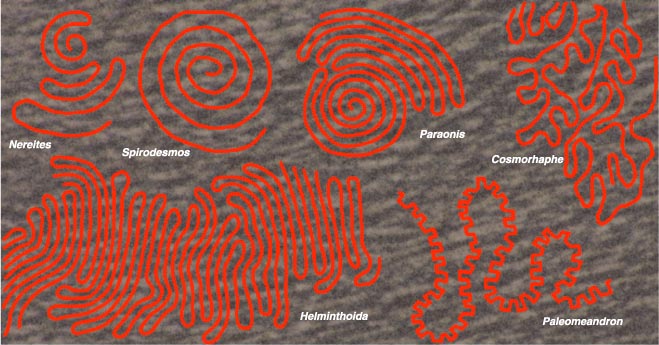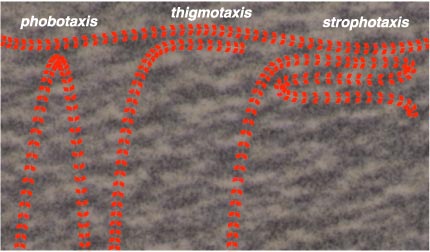U n i v e r s i t é Y O R K U n i v e r s i t y
ATKINSON FACULTY OF LIBERAL AND PROFESSIONAL STUDIES
SCHOOL OF ANALYTIC STUDIES & INFORMATION TECHNOLOGY
S C I E N C E A N D T E C H N O L O G Y S T U D I E S
NATS 1800 6.0 SCIENCE AND EVERYDAY PHENOMENA
ATKINSON FACULTY OF LIBERAL AND PROFESSIONAL STUDIES
SCHOOL OF ANALYTIC STUDIES & INFORMATION TECHNOLOGY
S C I E N C E A N D T E C H N O L O G Y S T U D I E S
NATS 1800 6.0 SCIENCE AND EVERYDAY PHENOMENA
Lecture 1: Of Worms, Fossilized Scribbles, and Science
| Prev | Next | Search | Syllabus | Selected References | Home |
Topics
-
I wish to start the course by giving you a taste of how I intend to approach each topic. I have chosen a recent article
that appeared in the September-October 2003 issue of American Scientist.
The article is by Brian Hayes, and is entitled
 In Search of the Optimal Scumsucking Bottomfeeder.
If you wonder whether this topic is really an 'everyday phenomenon,' you are quite right. Yet,
the situation described—coming across 'fossilized scribbles in stone'—is not at all unusual. It is
quite easy to find fossils, even in Toronto, and to find fossils that display some sort of puzzling pattern. In
any case, the emphasis in this lecture is on the kind of questions a scientist asks when confronted with any novel
phenomenon (in this case the fossilized patterns illustrated in the first figure below). So, even if you are not at all
interested in fossils, bear with me (and with Brian Hayes, the author of this article), and try to see what makes a
scientist's mind tick, generally.
In Search of the Optimal Scumsucking Bottomfeeder.
If you wonder whether this topic is really an 'everyday phenomenon,' you are quite right. Yet,
the situation described—coming across 'fossilized scribbles in stone'—is not at all unusual. It is
quite easy to find fossils, even in Toronto, and to find fossils that display some sort of puzzling pattern. In
any case, the emphasis in this lecture is on the kind of questions a scientist asks when confronted with any novel
phenomenon (in this case the fossilized patterns illustrated in the first figure below). So, even if you are not at all
interested in fossils, bear with me (and with Brian Hayes, the author of this article), and try to see what makes a
scientist's mind tick, generally.
-
" The study of trace fossils—as distinct from body fossils— is the discipline known as ichnology (from the Greek ichnos, footprint). It is practiced by a small but thriving community, which has its own journals, conferences, traditions and vocabulary. Lots of vocabulary. Ichnology lives in a kind of parallel universe set apart from the rest of paleontology, identifying and naming "ichnospecies," which often have no known correlates among conventional biological species. In other words, ichnologists may conclude that various trace specimens were all made by the same kind of organism (thus constituting an ichnospecies), but they can rarely associate the ichnospecies with an animal known from body fossils."
This is an important statement, because it applies practically to all areas of science. Each area creates its own small, or large, world, but not an isolated world. The journals it publishes, the conferences it convenes represent the link with the rest of science and with the world we all inhabit. The findings so communicated are therefore open to scrutiny, to rebuttal. to verification, to revision. But of course, if you are not an 'ichnologist,' your contributions to any such debate will have less weight than those of an insider, and here lies one of the most difficult and pervasive issues in science: nobody can even dream of being an insider in all areas of science. We all, scientists and non-scientists alike, must exercise a certain measure of 'faith' or 'trust.' But on what basis? Our trust can not be blind, unconditional; it must be grounded on some open, rational principles. One fundamental answer, in its briefest terms, lies in the principle of peer review. "Peer review is an integral part of the scientific process. The reason we 'trust' peer-reviewed articles more than non-reviewed ones is that other reviewers who usually don't have a vested interest in our article have evaluated its merits and found it to be scientific (or not). In other words, the data presented is probably not forged, unclear, or unrepeatable, the method of data collection is sound, etc." [ from M F Bonnan, What Good is Peer Review? ] -

Fossilized Scribbles in Stone.
(Reprinted by permission of American Scientist, Magazine of Sigma Xi, The Scientific Research Society.)"Fossilized scribbles in stone are thought to be trails left by marine worms inhabiting the seafloor. The two principal motifs are the Archimedean spiral, seen most clearly in Spirodesmos, and the zigzag meander, as in Helminthoida. Nereites combines the two patterns. So does Paraonis, but this specimen is not a fossil; it is created by an annelid worm that inhabits Atlantic beaches. Cosmorhaphe and Paleomeandron have recursive, multiscale meanders. The drawings are not all to the same scale, and of course such an assembly of fossils can never be found in a single rock outcrop."
This figure illustrates the kind of objects Brian Hayes became intrigued by. Notice that he is not an 'ichnologist.' His area of expertise is rather computer science. In other words, he didn't find these objects somewhere in a rock layer, but in …"a letter from Mark A. Wilson of the College of Wooster, who pointed out that some of my computer-generated paths were anticipated by millions of years in the fossil record of early life." This kind of 'encounter' is not at all uncommon in science, and represents one of the ways in which science overcomes the insularity of specialized areas. The meeting of two different scientific fields, however, has its own dangers. The mere fact that the fossil scribbles are similar to the patterns generated by some computer program does not, by itself, point to the latter as an explanation of the former." When I first saw the photographs in Trace Fossils and Problematica, I assumed that the meandering paths had been inscribed by animals browsing on the surface of the seafloor, like snails leaving a slime trail on the glass of an aquarium. My assumption was mistaken; most of the fossils are actually burrows formed by worms living below the sediment surface. This was my first clue that understanding the nature of the trails might require some actual knowledge of fossils, rather than merely treating them as an exercise in abstract pattern formation."
Scientists sometimes forget this kind of respect for empirical data. Herein lies the danger, which is sometimes so subtle as to escape detection. For example, as Hayes points out repeatedly in his article, "the question of why the worms evolved these peculiar habits is harder to resolve. The assumption has always been that they were optimizing their feeding strategy, maximizing the input of food while minimizing the effort to acquire it. This is still the leading hypothesis, but perhaps there is room for doubt." -
The basic assumptions (in addition to the one referred to at the end of the preceding bullet) are summarized
in the second figure.

Three Basic Patterns of Behavior.
(Reprinted by permission of American Scientist, Magazine of Sigma Xi, The Scientific Research Society.)"Three basic patterns of behavior underlie most theories of the spiral and meandering trace fossils. Phobotaxis forbids a worm to cross its own trail. Thigmotaxis compels a worm to stay close to an existing trail. Strophotaxis is a propensity for making U-turns."
These behaviors seem reasonable, and certainly represent a plausible interpretation of the patterns observed in the fossils. But "reasonable" and "plausible" reasoning can only lead to a hypothesis, not necessarily to an explanation, and the resulting hypothesis must be testable. This is one of the cardinal principles of science. In this case it is far from clear how the hypothesis might be tested. For example, as Hayes points out, " the traces that resemble self-avoiding walks have been classified in ichnospecies such as Nereites cambrensis (from the Paleozoic era) and Helminthoida labyrinthica (found in Cretaceous and Eocene strata). None of these ichnospecies have been matched with known organisms, but most authors suggest they were worms of one kind or another." If we don't know which actual species of organisms were responsible for the scribbles, we don't know where to look for similar, but living species whose behavior may test our hypothesis. At least for the time being, we are stuck. -
But what about Hayes' success in 'predicting' the patterns that would be excavated by a worm obeying the three
basic behaviors described above? Here are Hayes' sobering words:
"But perhaps the program's ability to match the fossil patterns is not so surprising, since it was designed explicitly for that purpose. Present-day tastes favor a less direct approach. The rules of phobotaxis and thigmotaxis—which together cause the worm to adhere to its own path without crossing it—seem natural enough, but strophotaxis—the penchant for making U-turns—is something one would like to see emerge from simpler rules rather than being a built-in axiom."
This question betrays one of the fundamental insecurities that all scientists ultimately have: how is it possible to guess how nature will express itself, or how is it possible that our necessarily limited observations and understanding can nevertheless lead us to predict her behavior? We don't quite know the answer, and that's in part why we try to rely as much as possible on the evidence that nature itself offers. In other words: if the number of assumptions we make is too large, we may have the illusion that we have explained a piece of nature, while in fact we have been caught in a vicious logical circle (we have built into our assumptions the answers we expect). This is why the fewer assumptions a successful theory is built on, the more likely to be true is the theory. This is why Hayes tries to reduce the number and complexity of the basic behahiors initially postulated. - This case can lead to many other questions and problems, which I hope will emerge during our live discussion.
Readings, Resources and Questions
- An excellent Introduction to Ichnology. The Study of Plant and Animal Traces by Anthony Martin, is available from Emory University.
- A good review article on peer review is J P Kassirer, Peer Review: Crude and Understudied, but Indispensable,
- In addition to peer review, what else can help ensure the reliability and trustworthiness of scientific results?
- Which other lessons about the nature of science does Hayes' article teach us? Hint: read the first few chapters of A F Chalmers, What is This Thing Called Science? An Assessment of the Nature and Status of Science and Its Methods. U of Queensland Press, 1976, 1994. Or similar texts.
© Copyright Luigi M Bianchi 2003-2005
Picture Credits: American Scientist
Last Modification Date: 20 September 2005
Picture Credits: American Scientist
Last Modification Date: 20 September 2005